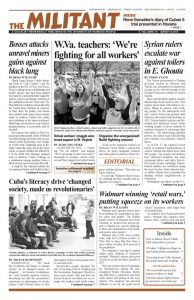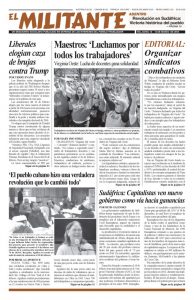Determined to advance their political and military interests in Asia, the U.S. rulers are increasing airstrikes in Afghanistan. Washington hopes to preserve the weak Afghan government and both contain recent gains by the Taliban and force negotiations with them.
Begun on the heels of al-Qaeda’s terror attack on the World Trade Center and Pentagon in 2001, the U.S. rulers’ Afghan war drove the Taliban from power. The assault complemented Washington’s war in Iraq. In both theaters, Washington sought to re-establish control and stability to defend U.S. imperialism’s reach in Asia and the Middle East.
After 17 years of war — the longest in U.S. history — the U.S. rulers have not succeeded in forcing an end to the fighting or establishing a stable and authoritative government in Afghanistan. Today the Taliban has a presence in two-thirds of the country. Three suicide bombings by Islamist terrorists in Kabul, the capital, took the lives of 130 people over 10 days in January.
Since the war began, the challenges confronting Washington have grown substantially. Capitalist nations across Asia have become more reliant on economic relations with Beijing, in a region the U.S. rulers considered the chief spoil of their bloody victory in the second imperialist world war.
Presenting the U.S. government’s new National Defense Strategy Jan. 19, Defense Secretary James Mattis highlighted Washington’s rivalry with its capitalist competitors in Moscow and Beijing. Mattis announced “great power competition, not terrorism, is now the primary focus of U.S. national security.”
“China is a strategic competitor using predatory economics to intimidate its neighbors while militarizing features in the South China Sea,” he says. Mattis points to the rulers in Moscow, Iran and North Korea as additional big problems.
Speaking for the U.S. propertied owners, Mattis says they face a future of “reduced access to markets that will contribute to a decline in our prosperity,” unless they mount a robust response.
“For decades the United States has enjoyed uncontested or dominant superiority in every operating domain,” Mattis says. This is being challenged today, he laments.
The rulers’ conclusion? “Long-term strategic competitions with China and Russia” and “Build a more lethal force.”
In early January Washington suspended military aid to Pakistan, saying its government allowed the Taliban to launch attacks on Afghanistan. Pakistan Foreign Minister Khawaja Asif replied that his government no longer was allied with Washington.
At the beginning of the Afghan war the Pervez Musharraf regime in Pakistan was transformed from a protector of the Taliban into an unstable ally of the U.S. government. Islamabad provided Washington with airbases for its bombing assaults. In 2009 the Pakistani rulers waged brutal attacks on people in areas of Pakistan controlled by the Taliban, aided by U.S. special forces and drone strikes.
But today Beijing has overtaken the U.S. capitalists as the biggest investor in Pakistan, building massive infrastructure projects there that facilitate the export of Chinese-made goods to capture markets in Europe and Africa. At the same time Beijing has made investments in the Pakistani military.
Ruins impact on working people
Sometime ago Washington abandoned any notion that it could win the Afghanistan war. Today it seeks to use stepped-up airstrikes on Taliban positions to force them to talk. The Pentagon announced deployment of 300 more Marines to the country’s Helmand province Jan. 8. Tens of thousands of Marines fought bloody battles there until President Barack Obama ordered a withdrawal from the area in 2014, declaring the U.S. combat mission was over. The Taliban moved back in and took control of parts of the province.
For more than a decade the Pentagon has said it was getting closer to turning the war over to the Afghan military.
With a further 1,000 troops due in April, total U.S. troop deployment will rise to 15,000. While this stands in contrast to the 100,000 U.S. soldiers in Afghanistan in 2010, it shows Washington’s inability to extricate itself from the war. U.S. forces increased the number of airstrikes last year, pushing the Taliban back from several districts. But the cost was a rash of civilian deaths. The Pentagon announced Feb. 1 it was taking steps to once again expand training of Afghan forces.
Concerned that they won’t be able to recruit sufficient cannon fodder from among the Afghan toilers as Kabul’s soldiers death toll mounts, Washington and the Afghan government decided last October they would withhold information on the number of Afghan soldiers killed.
The U.S. rulers’ war has worsened the ruinous conditions faced by working people. Over 400,000 were forced to flee their homes last year alone, and in the course of the conflict millions have become refugees, fleeing to Pakistan and Iran. According to the U.N., 3,438 Afghan civilians were killed last year.
Seventeen years of U.S.-led “reconstruction” has done nothing to address the abysmal conditions working people there face. Half the population of Afghanistan has no access to electricity, 60 percent are illiterate and average life expectancy is 51 years. Tens of thousands of farmers see growing poppies for the drug trade as the only way to survive.
The cleric-led capitalist regime in Iran initially opposed the Taliban, which is based among Sunni Muslims, and backed Washington’s efforts to oust them from power. But as the U.S.-led intervention expanded, the Iranian rulers decided they could expand their counterrevolutionary clout more effectively by turning against Washington. They began providing money, training and weapons to the Taliban.
Roots of Afghanistan war
The Taliban has its origins among Islamist groups cobbled together by the U.S. rulers to fight the 1979 invasion of Afghanistan by the Soviet Union. A popular revolution had opened space for working people there in 1978, but in the absence of a revolutionary working-class leadership, the Stalinist-led People’s Democratic Party of Afghanistan came to power. This government became increasingly isolated, refusing to respond to the needs of the toilers or mobilize peasants and other working people to advance their interests against the landlords and capitalists.
Moscow intervened militarily in 1979 to back one faction within the PDPA that was engaged in a murderous struggle against opponents in the party.
In the course of a 10-year war with U.S.-backed Islamist forces, which included Osama bin Laden and others who became the leaders of al-Qaeda, some 15,000 Soviet workers in uniform were killed. The war became increasingly unpopular at home. Moscow withdrew its troops in 1989. The anti-war discontent and military defeat were among the causes of the Soviet Union’s implosion.

